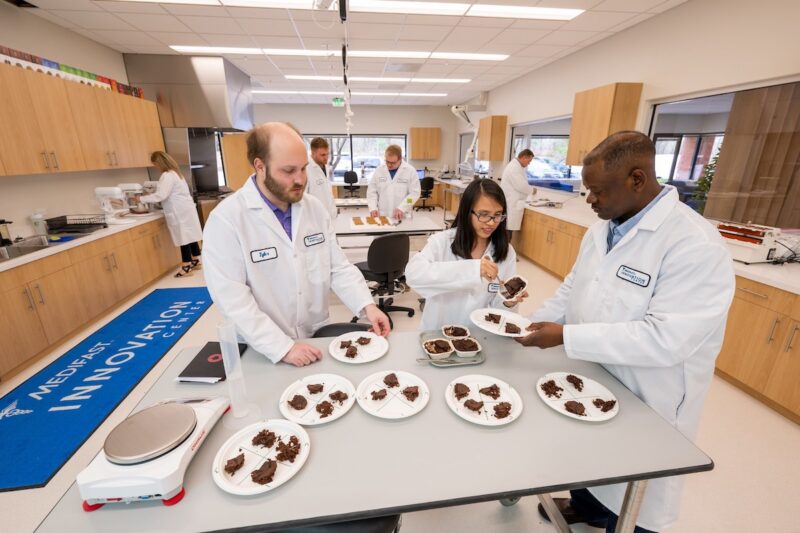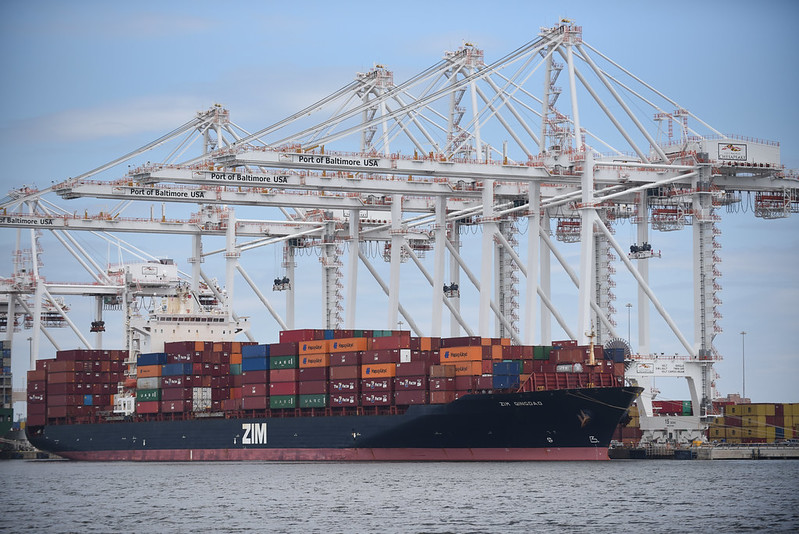With households spending more than ever on discretionary items like dieting and wellness products, the company’s sales spiked to an all-time high and it announced plans to ramp up hiring in Maryland to support distribution.
It was a very different story by mid-2022: The economy had cooled, as had the market for Medifast’s supplements and dietary products, thanks to rising inflation and a consumer spending slowdown that caused initially high growth expectations to drift out of reach. Medifast’s year-over-year profits for Medifast dropped 17% in the second quarter of 2022, and in August, the company lowered growth expectations for the rest of 2022. Several weeks later, in August, it filed a notice with the Maryland Department of Labor announcing the layoffs of 134 workers at its distribution center in Ridgely — a sturdy employer in Eastern Shore’s Caroline County since 2003. The cuts affected 50 workers from Caroline County and dozens more from surrounding Eastern Shore communities in Maryland and Delaware.
“My immediate thought when I heard about it was, taking it from an empathetic standpoint, ‘Oh, those families, now they’ve got this to worry about, but at least there are tons of jobs available,’” recalled Debbie Bowden, economic development director for Caroline County, during an interview in November. “I think I was grateful that they didn’t have to close down the facility. I am watching now to make sure that that isn’t the next step, given that other similar types of facilities have shut down on the Eastern Shore.”
While layoffs at the tech and ecommerce giants were the big story in 2022 — high-profile examples include Meta, Microsoft, Walmart, Amazon and Shopify — the tale has been similar for smaller-market employers and startups hurting from reduced valuations and expectations, as well as slowing consumer spending. Technical.ly has reported on a number of these cuts, including multiple layoff rounds at Philadelphia-based instant consumer needs delivery specialist GoPuff and other announced job cuts at Pittsburgh robotics firm SeeGrid and ID.me in Northern Virginia. From tech hubs and urban centers out to rural areas like Maryland’s Eastern Shore, in which both Medifast and USA Fulfillment slashed positions en masse, more companies have been consolidating operations and hedging their initial 2022 growth expectations.

For startups dependent on investment capital, there’s a certain “reality check” afoot after the early COVID-era moment when interest rates were lower and cash was more freely available, said Daraius Irani, chief economist at Towson University’s Regional Economic Studies Institute.
“Now, the cost of borrowing has gone up, so people are a little bit reluctant to borrow money” and invest, he noted.
Meanwhile, inflation continues to hamper consumer spending — yes, even during the usually retail-crazed holidays — and with looming forecasts of an economic recession in 2023, retail-oriented firms large and small are in a humbling economic moment.
“The real challenge,” Irani said, “will be obviously that, as we’re going into this recession with big interest rates, that’s always going to make it a challenging environment for any discretionary or large-ticket items and purchases.”
Laid off, but in demand?
As Bowden noted in Caroline County, there’s a silver lining for the lower-level distribution and fulfillment workers who feel the sting of consolidation: There are other jobs for them to fill at present. As of late 2022, unemployment remained relatively low on the Eastern Shore and across Maryland, with a statewide seasonally adjusted rate of 4.3% (compared to a national rate of 3.7%) in November, per the most recent figures from the U.S. Bureau of Labor Statistics. And, in a still-tight labor market favoring applicants, there’s still demand for warehouse workers who can keep products moving.

In the case of Medifast’s layoffs, a system for resources and outreach sprang into action, with the Upper Shore Workforce Investment Board (WIB) hosting a job fair in October and other “rapid response” meetings to connect with affected workers. Representatives from the Maryland Department of Labor and Chesapeake College connected with layoff-affected individuals to provide information about unemployment benefits, job training resources and more. Caroline County Public Schools leadership also reached out to students whose families were affected.
“That rally cry, based on that news, was immediate,” Bowden said.
But the tenor to the situation was different than during the last period of major layoffs in 2012, when the Shore, along with much of rural America, was still reeling from the Great Recession.
“There seemed to be an appreciation for the services there and a hopefulness,” Bowden said of the mood at the October job fair for Medifast’s Ridgely workers. “And I think that is key in these economic times and this labor market.”
Daniel Schneckenburger, executive director of Upper Shore WIB, recalled speaking with two now-former Medifast workers who were set to lose their positions coming to the Oct. 4 job fair and were actively with companies hiring for their same skillset.
“Employers still have a lot of opportunities for people,” he said, adding, “It’s never a good time to get laid off, but this is probably one of those times when you could actively get out there” and hunt for jobs.
Reached for comment, a Medifast spokesperson did not respond to a question about whether the company planned to rehire any laid-off workers but said in a statement: “The company has had a presence in Caroline County since 2003 and the distribution center continues to be important to Medifast’s business. As new opportunities become available, we will evaluate our staffing needs.”
Upskilling for the future
In addition to hosting events with employment and benefits sources for displaced workers, another focus of the Upper Shore WIB (and workforce investment boards in general) is encouraging workers to get new skills and training — particularly in more secure industries. Schneckenburger hopes the WIB can partner with more employers to funnel workers into apprenticeship programs, which have received more state resources and attention in recent years.
Fulfillment and warehousing jobs, while often in high demand, are not meant to be “forever jobs,” said Kelly Schulz, a former state commerce secretary recently tapped to lead the Maryland Tech Council (MTC). Rather, she argued, those roles should be a way to introduce entry-level workers to an industry in which they can learn, train and advance.
Upskilling, Schulz said, can help workers to find more secure, better-paying jobs while simultaneously feeding Maryland’s growing tech sector with in-state workers rather than labor drawn from elsewhere. The MTC has fixated on this goal with its BioHub Maryland, a workforce development initiative that supports life sciences growth in the state and has drawn $5 million in combined state and federal financing within the last year.

The top concern from the MTC’s members, Schulz said, is meeting workforce demands — particularly for employees skilled in tech manufacturing and research and development.
“It’s a varied type of employee that they need,” she said. “Whatever role we can play at MTC to get this right, it’s a big deciding factor for a lot of companies in deciding where to go — or even for businesses deciding whether to stay and expand.”
As for Maryland’s broader 2023 employment forecasts, observers aren’t sounding the alarm just yet. Towson’s Irani expects companies to redefine operations in the state. An example of this would be trimming costs for multiple leases in a given area, as Amazon did in October when it announced shuttering of two Baltimore-area warehouses while transferring employees to other facilities.
However, Irani described it as “still a really good labor market,” with about two jobs available for every unemployed person and companies actively seeking workers to fill open positions.
Schneckenburger admitted that he “would be a little antsy” if he worked in a warehouse role for a consumer goods-oriented company, though.
“I am concerned about fulfillment,” he said. “If your business model is based on consumer spending, you’re probably looking very hard at the future. In 2023, what’s that environment look like? Is it going to be the same? Is it going to be worse?”

Schulz, for her part, remains bullish on the state’s resiliency in 2023. Manufacturing and logistics are strong in Maryland thanks to its 109-mile segment of the I-95 corridor, the Port of Baltimore and freight rail connections. These have collectively spurred development of millions of square feet of new logistics space in recent years, stretching from population centers in the DC suburbs and Baltimore to more rural reaches like Washington County and the Eastern Shore.
The former commerce secretary is optimistic about the durability of these sectors — and their workers’ employment prospects — even despite last year’s economic challenges of the past year. Citing still-strong hiring demand and the pipeline of fulfillment- and ecommerce-related construction in Maryland, she said recent layoffs like those at Medifast aren’t the rule, but rather “a blip” after the company overshot its growth goals.
“There’s a little bit of a correction that’s happening, and I think we’re going to continue to see growth moving forward, especially in Maryland,” she said.







